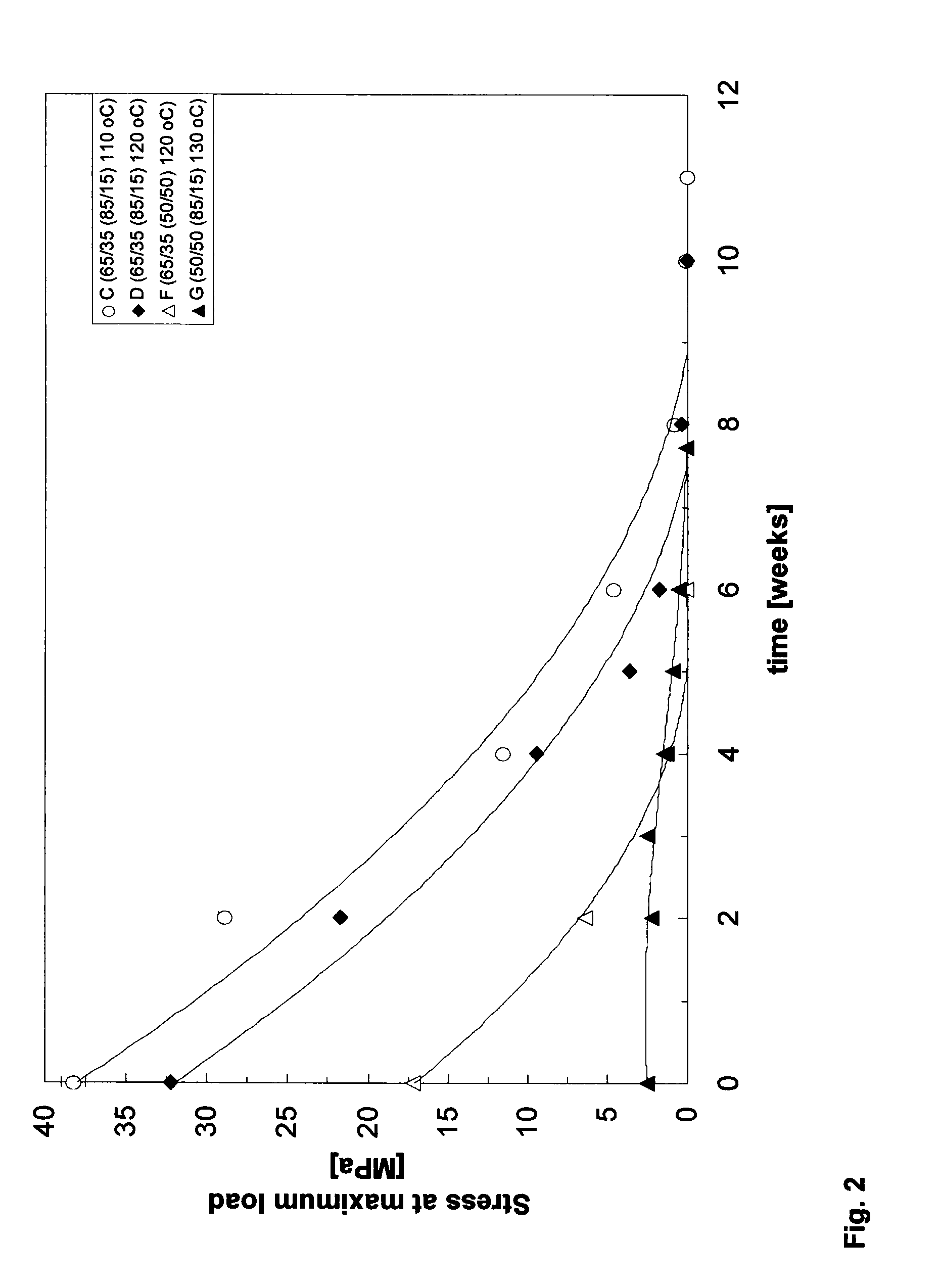DL-Lactide-Epsilon-Caprolactone Copolymers
a technology of caprolactone and dllactide, which is applied in the direction of prosthesis, blood vessels, catheters, etc., can solve the problems of affecting the function of nerves, affecting the regeneration of nerves, and unsuitable material for clinical applications of biodegradable nerve guides
- Summary
- Abstract
- Description
- Claims
- Application Information
AI Technical Summary
Benefits of technology
Problems solved by technology
Method used
Image
Examples
example i
[0060]DL-Lactide and L-Lactide (ratio 70:30) (Purac, the Netherlands) were introduced into a vessel under nitrogen atmosphere and the monomers were dried in vacuum at 45° C. for at least 8 hours. ε-Caprolactone (Acros, Belgium) is dried over CaH2 and distilled under reduced pressure in a nitrogen atmosphere. The lactide and ε-caprolactone were added under a nitrogen flow in a glass ampoule in a monomer ratio of 50:50. The catalyst was added in an amount of 1·10−4 mole of catalyst per mole of monomer (M / I=1·10−4). The ampoule was cooled in liquid nitrogen and sealed under vacuum (10−6-10−−7 mbar). The ampoule was warmed to room temperature and then to 110° C. The contents were shaken until the mixture became homogeneous. The polymerization took place at 110° C. during 14 days.
[0061]The monomer conversion was 85%. The lactide content in the polymer was 67%. The intrinsic viscosity was 5.2 dl / g. The molecular weight, Mw, (measured by GPC) is 700000. The polydispersity, D, is...
example ii
[0062]DL-Lactide (Purac, the Netherlands) was introduced into a vessel under nitrogen atmosphere and the monomer was dried in vacuum at 45° C. for at least 8 hours. ε-Caprolactone (Acros, Belgium) was dried over CaH2 and distilled under reduced pressure in a nitrogen atmosphere. The lactide and ε-caprolactone were added under a nitrogen flow in a glass ampoule in a monomer ratio of 50:50. The catalyst was added in an amount of 1.2×10−4 mole of catalyst per mole of monomer. The ampoule was cooled in liquid nitrogen and sealed under vacuum (10−6-10−7 mbar). The ampoule was warmed to room temperature and then to 130° C. The contents were shaken until the mixture became homogeneous. The polymerization took place at 130° C. during 66 hours (3 days).
[0063]The monomer conversion was 88%. The lactide content in the polymer was 56%. The intrinsic viscosity was 4.2 dl / g. Precipitation of the polymer in ethanol (from a chloroform solution) yielded a polymer with an intrinsic viscosi...
example iii
[0065]DL-Lactide and L-Lactide (ratio 70:30) (Purac, the Netherlands) were introduced into the reaction vessel under nitrogen atmosphere and were dried in vacuum at 45° C. for at least 8 hours. ε-caprolactone (Acros, Belgium) is dried over CaH2 and distilled under reduced pressure in a nitrogen atmosphere.
[0066]Glass ampoules are covered inside with a teflon sheet (fluortec) and are dried in an oven during one night. ε-Caprolactone was added to the lactide in the vessel in a monomer ratio 62 / 38 mol / mol (lactide / ε-caprolactone). The catalyst was added in an amount of 1×10−4 mole of catalyst per mole of monomer. After 20 minutes of homogenisation at 120° C. the mixture was poured into the glass ampoules under nitrogen flow, after which the ampoules were closed with a stop. The ampoules were placed at 110° C. for 312 hours (13 days). The intrinsic viscosity was 6.2 dl / g. The monomer conversion was 95%. The lactide content in the polymer (calculated by NMR) was 65%.
PUM
| Property | Measurement | Unit |
|---|---|---|
| polydispersity | aaaaa | aaaaa |
| polydispersity | aaaaa | aaaaa |
| temperature | aaaaa | aaaaa |
Abstract
Description
Claims
Application Information
 Login to View More
Login to View More - R&D
- Intellectual Property
- Life Sciences
- Materials
- Tech Scout
- Unparalleled Data Quality
- Higher Quality Content
- 60% Fewer Hallucinations
Browse by: Latest US Patents, China's latest patents, Technical Efficacy Thesaurus, Application Domain, Technology Topic, Popular Technical Reports.
© 2025 PatSnap. All rights reserved.Legal|Privacy policy|Modern Slavery Act Transparency Statement|Sitemap|About US| Contact US: help@patsnap.com



